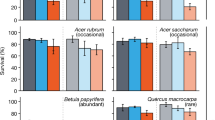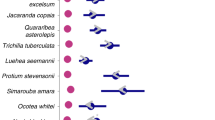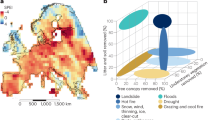Abstract
WHILE recently there has been much emphasis placed on the examination of the effects of chronic irradiation on intact whole forest ecosystems, the response of individual forest species following acute irradiation has received much less attention. At present only a limited amount of information is available concerning the effects of acute irradiation on the genus Pinus. Working at Brookhaven, Sparrow et al. have reported on Pinus strobus1, and a second group under Shields has reported on Pinus monophylla2. The purpose of the work recorded here was to examine the response of Pinus thunbergii seedlings to acute γ-radiation under controlled laboratory conditions as opposed to that under the field conditions as examined by other workers1,2.
This is a preview of subscription content, access via your institution
Access options
Subscribe to this journal
Receive 51 print issues and online access
$199.00 per year
only $3.90 per issue
Buy this article
- Purchase on Springer Link
- Instant access to full article PDF
Prices may be subject to local taxes which are calculated during checkout
Similar content being viewed by others
References
Sparrow, A. H., Schairer, L. A., Sparrow, R. C., and Cambell, W. T., Rad. Bot., 3, 169 (1963).
Brandenburg, M. K., Mills, H. L., Rickard, W. H., and Shields, L. M., Rad. Bot., 2, 251 (1962).
Mergen, F., and Johansen, T. S., Rad. Bot., 3, 321 (1963).
Author information
Authors and Affiliations
Rights and permissions
About this article
Cite this article
OKUNEWICK, J., HERRICK, S. & CARLSEN, E. Early Response of Pinus thunbergii to Acute γ-Irradiation. Nature 204, 394–395 (1964). https://doi.org/10.1038/204394a0
Published:
Issue Date:
DOI: https://doi.org/10.1038/204394a0
This article is cited by
Comments
By submitting a comment you agree to abide by our Terms and Community Guidelines. If you find something abusive or that does not comply with our terms or guidelines please flag it as inappropriate.



